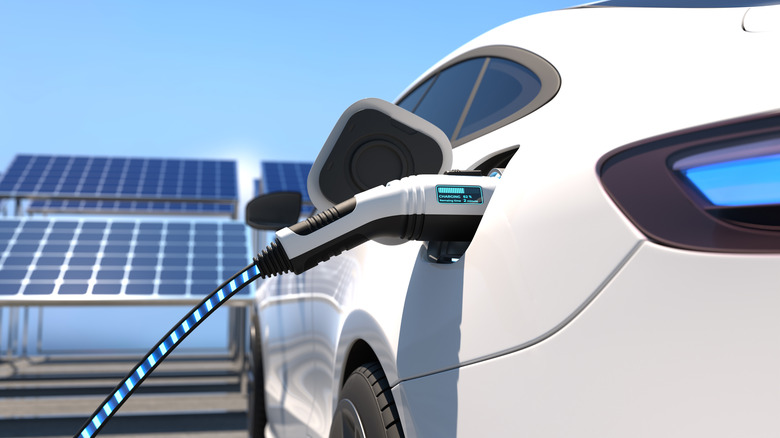Can Solar Panels Charge An Electric Car? EV Charging Requirements Explained
There are a variety of EV models available today from major industry leaders, like Chevrolet, Tesla, BMW, and Hyundai. While these battery-powered automobiles don't emit nitrogen oxides (NOx) like gasoline motor vehicles do, what about the energy sources used to charge EVs? Renewable sources of energy have been growing, but in 2023 fossil fuels still accounted for 70% of provided energy worldwide, per Forbes. So, while the electric car may not expel emissions, plugging into your home charger could be utilizing power made from fossil fuels.
The idea of using solar panels to charge an EV has been floating around, with many consumers curious to find out if it's a solid alternative. To clarify, you can't run energy directly from solar panels into your car's EV battery. Solar energy levels fluctuate based on a variety of factors, such as the weather. So to use the sun's rays to power your EV, you would want to invest in energy storage technology like Tesla's Powerwall. Once the energy from your solar panels is stored in a home battery system and converted into AC with an inverter, you can then recharge your EV with renewable sources. The Powerwall from Tesla includes lithium-ion battery packs and an inverter, but if you opt to build your own home energy system, you'll need solar panels, an inverter, and batteries.
There are, of course, plenty of things you need to know before installing solar panels on your home – and that's true if you plan on using solar panels to charge an electric car, too.
How many panels are needed?
It usually requires between seven and 12 solar panels to charge an EV, but it's highly dependent on sunlight and the amount you travel in the car, among other variables. According to the Federal Highway Administration, the average American racks up over 13,400 miles every year, in which case an EV would require just under 12 kWh daily for charging. To power the typical home, approximately 20 solar panels may be required, so it's possible (if EV charging uses 12 panels) that more than half of the renewable energy collected for your house would go towards your EV. With a bit of math, you can learn exactly how many solar panels are needed to charge a Tesla.
While using the sun's rays sounds like a great idea to power a zero-emissions electric car, in practice, the results are inconsistent. The issue goes back to the nature of solar energy and its reliance on specific conditions for optimal results. In the U.K., the frequent overcast clouds and chilly winters may enable solar panels to capture only a few kilowatt-hours of energy per day. While it's certainly possible to charge your EV with solar panels, you also run the risk of needing more electricity than what your renewable sources have on hand. Moreover, your renewable system won't run forever (here's how long home solar panels will typically last).
Why you might opt for an electric bill credit over charging your EV
The batteries in an EV typically operate for a minimum of 10 years before requiring a costly replacement. Given that a new battery could run anywhere from $2,500 up to amounts greater than $20,000, most EV owners want to do everything in their power to prolong the unit's lifespan. If you're recharging your EV using solar power, you may have to charge your car quite frequently depending on how much energy was collected by the panels. You might conclude that the solution would be to just charge your EV every day. Unfortunately, charging your EV too frequently can result in the battery degrading because of too many charging cycles.
Rather than coping with variable energy levels and over-cycling your EV battery using solar, you might consider another option. You could charge your EV the ordinary way and send any extra renewable energy you have on hand back to the grid for a credit on your power bill. In a process called net metering, you can sell back extra power to the utilities company and help offset energy you used from the grid. That said, net metering may not be available everywhere, and the results can vary depending on your location.


